A Comprehensive Guide to Spanish Culture and Traditions
Written by Sergio Fomenkov
Meet Sergio! A travel enthusiast with a zest for exploration, he's all about discovering Spain's beauty, especially the Canary Islands! 🏝️ As a true Canary Islands lover, Sergio dedicates his time to uncovering hidden gems and capturing stunning landscapes that make this paradise so unique. He combines his love for adventure and in-depth knowledge of the region to inspire fellow travelers and help them create unforgettable memories on their journeys through the Canary Islands and beyond! Follow Sergio on Instagram, Facebook, LinkedIn, and WikiData. ... show more
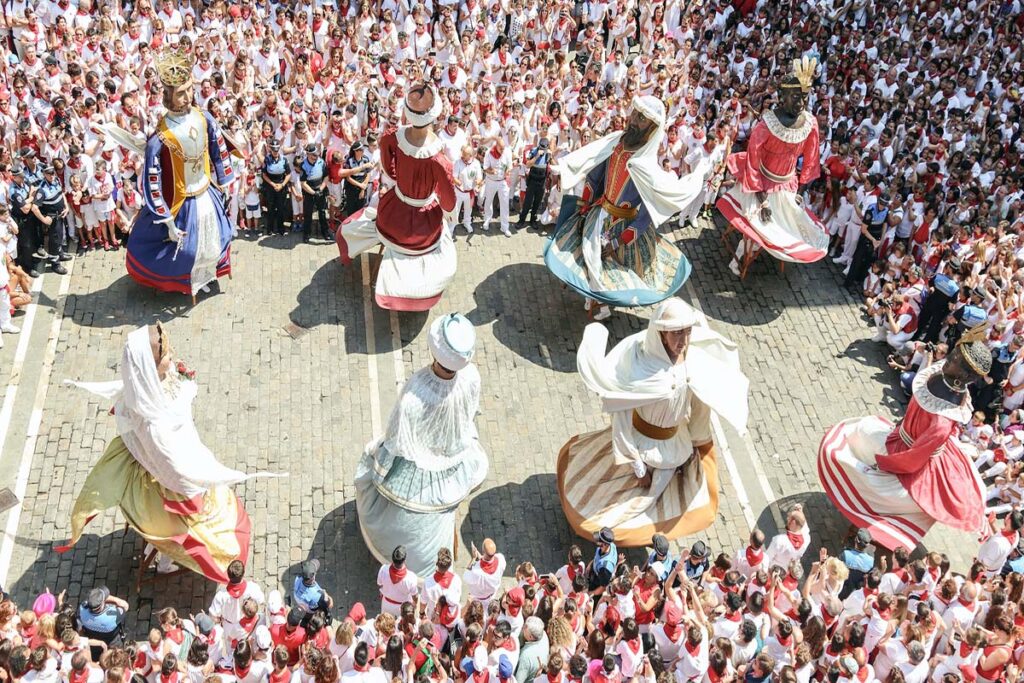
Spain, a vibrant jewel in Europe’s crown, captivates many of us with its breathtaking landscapes, architectural marvels, and deep-rooted history.
Its cultural tapestry, a rich weave of Greco-Roman, Christian, Muslim, and Arabic influences, has etched remarkable imprints globally, notably in Latin America.
Spain sparks images of flamenco rhythms, the thrill of bullfighting, the flavor of tapas, and the grandeur of literary classics like Don Quixote.
But wait! Its cultural saga extends way beyond these iconic elements. Ready to dig deeper?
With this blog post, I will unpack Spain’s rich traditions and customs, offering some insights for your travel bucket list. Let’s dive into it.
Key takeaways
- Spanish history has been influenced by numerous cultures, from the Romans and Moors to the reign of Catholic monarchs and the Franco dictatorship.
- While Castilian Spanish is the official national language, regional languages like Catalán, Galician, and Basque are also recognized.
- Strong family ties and the dual-surname tradition characterize Spanish family life.
- The majority of Spanish people identify as Catholics.
- Yes, Spain is famous for bullfights (and running with the bulls!), La Tomatina, and Semana Santa.
- Spanish cuisine, known for dishes like paella and tapas, offers many lesser-known regional delicacies.
What people say on Reddit
Cuisine. People think we only have tapas (small plates you share). That’s common when going out with friends and some people have them for dinner regularly. However, lunch is the main meal and we have a standard individual meal (2 courses, dessert and coffee). A lot of the dishes are never served to tourists (lentejas, cocido, fabada, vegetables, meat stews, fish…).
If you ever want to have real Spanish food go to a restaurant full of locals and ask for ‘Menu del día’. Tourists live in a parallel food reality where the less healthy food is served every day.
exxcathedra
Spain is one of the countries in the world where most lottery games are played. Some time ago I read a book on the subject by Roberto Gaviria, a sociologist.
An interesting point is that the first lottery in Spain was drawn by the government of the courts of Cadiz during the war of independence against the French. Buying lottery tickets became a patriotic act (the proceeds were used to finance the war).
Neat_Ad3722
Let’s all agree here that telenovelas or tv news are not the answer to get to know a culture, the best way is to travel and actually make friends in what ever country you go, but keeping in mind to what area you are going to be on, I wouldn’t go to a bad neighborhood to get to know the culture, I will learn other things but not about the culture, that is what I did when I went to Spain, Serbia and Thailand, people can’t get to know the American culture by watching America’s most wanted, get to facebook find a group and travel best experience ever.
alfi1205
The mascletà in Valencia! Imagine fireworks that are entirely sound and not visual. Now imagine one such large structure put up in the city center and set on fire. It’s like a million drums going full blast at once with all of the smoke and gunpowder you can imagine. During Falles you get one very large one every day but there are smaller ones throughout the city. I love them.
loves_spain
Spanish Language
One of the most distinctive cultural elements in Spain is the language. About 90% of Spanish residents speak Spanish (Castilian) as their first or second language. However, it isn’t the only one, as other languages like Catalan, Galician, Valenciano, and Basque have co-official status in various regions.
Cultural norms in Spain often reflect the relaxed, friendly demeanor that characterizes its people. One key point to note is that eye contact is prevalent and constant, more so than in many other countries.
Familiarity and intimacy are commonplace, which is why physical contact – a touch on the arm, back, elbow, or shoulder – is frequent during conversations. Spanish people usually stand close to each other, regardless of whether they’re in large groups or just two individuals conversing.
A common facet of Spanish communication is humor, often involving irony and light-hearted jokes, keeping smiles a near-constant presence.
If you asked an outsider to describe Spanish meetings in one word, “chaotic & quite loud” might be a common response. Even business meetings don’t fully embrace formality. They typically begin with personal and family-related conversations, extending their duration. If you’re from a different culture, you might feel as though you’re “wasting time” by frequently deviating from the meeting’s central topic.
Furthermore, interruptions are not uncommon, and turn-taking isn’t always adhered to. But this is completely normal and could indicate someone’s interest in your input.
I’ve heard radio hosts fervently interrupting each other, and to put it mildly, it was quite uncomfortable to listen to.
During personal interactions, Spanish people are emotive, interrupt frequently, and use plenty of gestures. Despite this lively interaction style, they remain respectful. They typically use the informal “tú” over the formal “usted,” reserved for the elderly, highly respected individuals, or official correspondence.
It’s also customary to greet people in the streets, shops, or elevators. Upon first meeting, acquaintances usually shake hands. Future encounters feature a warmer handshake, perhaps accompanied by a pat on the shoulder. Close friends or acquaintances greet each other with a hug and double-cheek kiss, even among men.
Additionally, they use lots of idiomatic expressions here, in Spain. These colloquial phrases are a staple in daily conversation, drawing on themes like food, animals, body parts, and flowers.
For instance, a well-spoken person is compared to a piece of bread – “un trozo de pan.” One of the phrases for being angry at someone misbehaving is “está de mala leche,” which literally translates to “he/she is a bad milk.”
Traditional Spanish Festivals and Celebrations
Spain is a treasure trove of unique traditions, with each region offering its own distinct flavor. The towns and provinces throughout Spain host an array of diverse festivals and holidays. The common thread is a shared enthusiasm, underpinned by an atmosphere of light-heartedness and joy.
Spanish people love social gatherings, and these celebrations provide the perfect opportunity for that. Typically, these holidays feature parades, dances, concerts, open-air markets, and of course, mouth-watering food.
Corrida (Bullfighting)
While it’s true that many people oppose bullfighting, others regard it as a fundamental aspect of Spanish culture. Around the beginning of the Common Era, Spain was entirely under Roman control. It was here that the Romans staged their famed gladiatorial battles, including man against bull and other large animals, even elephants. However, with the advent of Christianity, these combats gradually morphed into a more organized bullfighting spectacle.
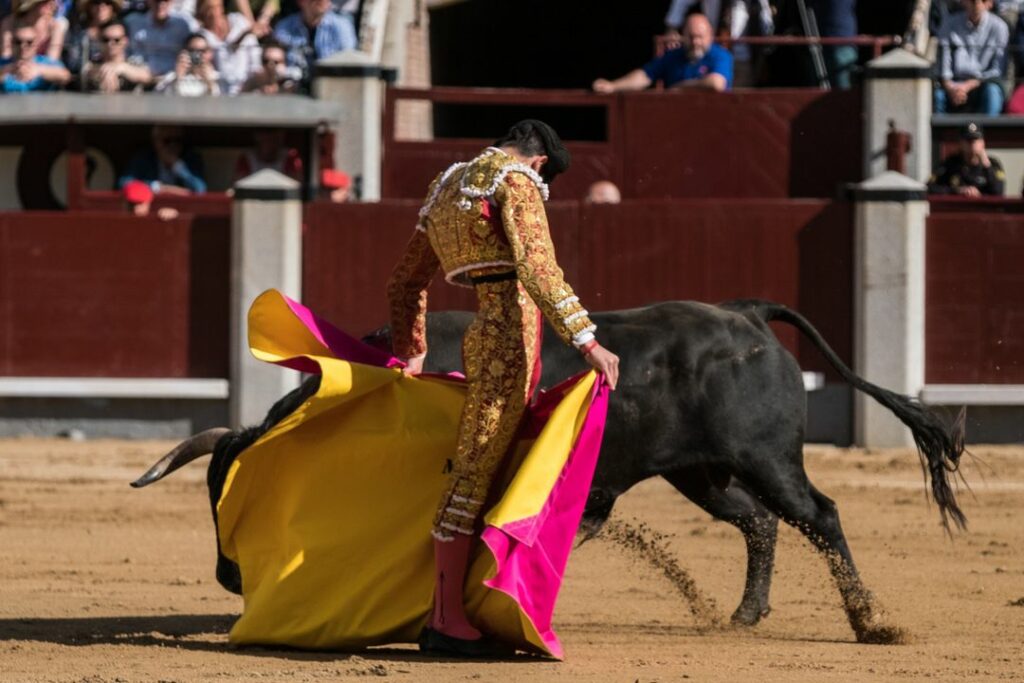
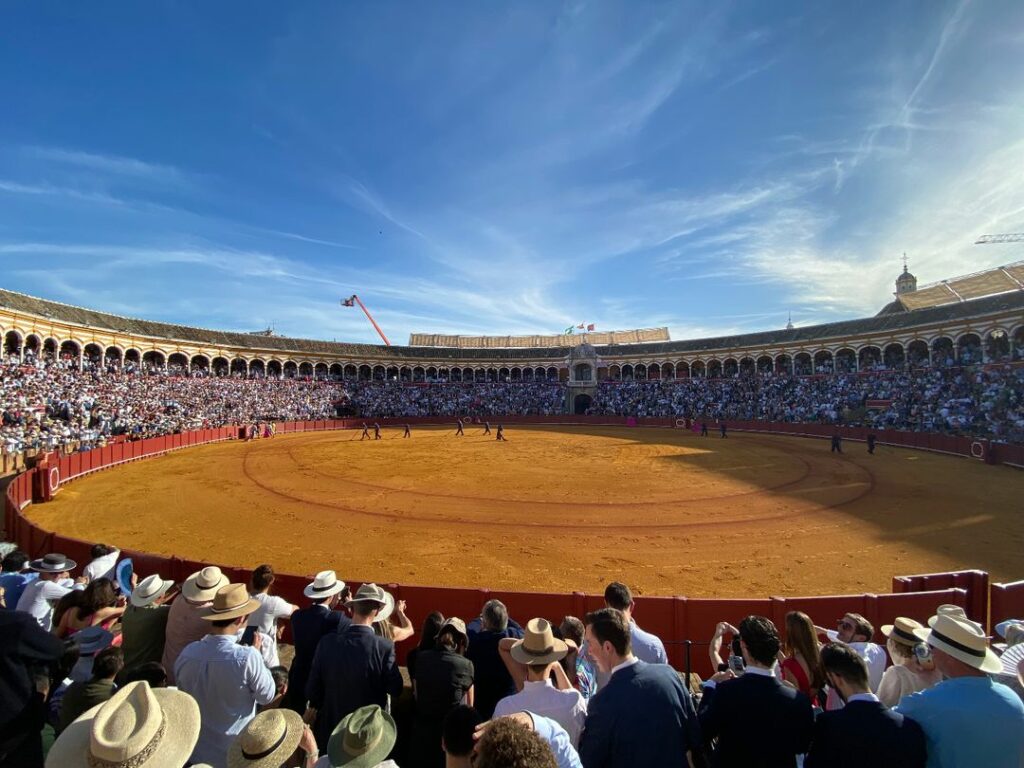
Interestingly, when the Arabs seized control of the Iberian Peninsula, they attempted to ban bullfighting. Spanish Christians interpreted this as a sign of resistance against the foreign infidels and embraced the sport as a means of cultivating bravery for war. Thus, bullfighting evolved into a national symbol of Spain.
Today, Spain is home to many advocates for the prohibition of bullfighting, particularly among animal rights activists. They argue that killing a bull in the arena is a harsh, blood-soaked spectacle that inflicts suffering on both the animal and many spectators. Bullfighting is currently banned in Catalonia and the Canary Islands.
Despite this, bullfighting persists in many parts of Spain. For your reference, here is a comprehensive list of cities, towns, regions (autonomous communities), and provinces in Spain where bullfighting is still conducted (as of the 2024 season):
La Tomatina
La Tomatina is an integral part of Spanish culture in Buñol, a town in the province of Valencia. It’s a fun event where participants throw tomatoes at each other. The story goes that it all started as a prank in 1949, but the joke eventually evolved into a vibrant tradition. The festival takes place on the last Wednesday in August at the Buñol Town Square.
Semana Santa
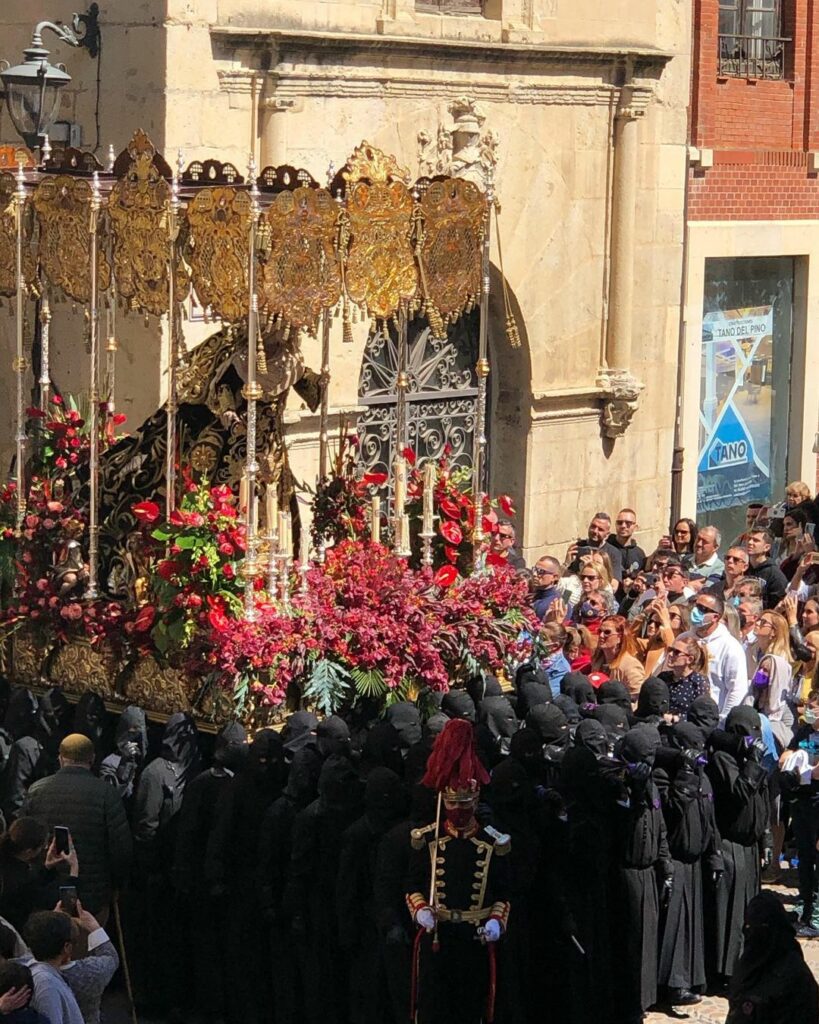
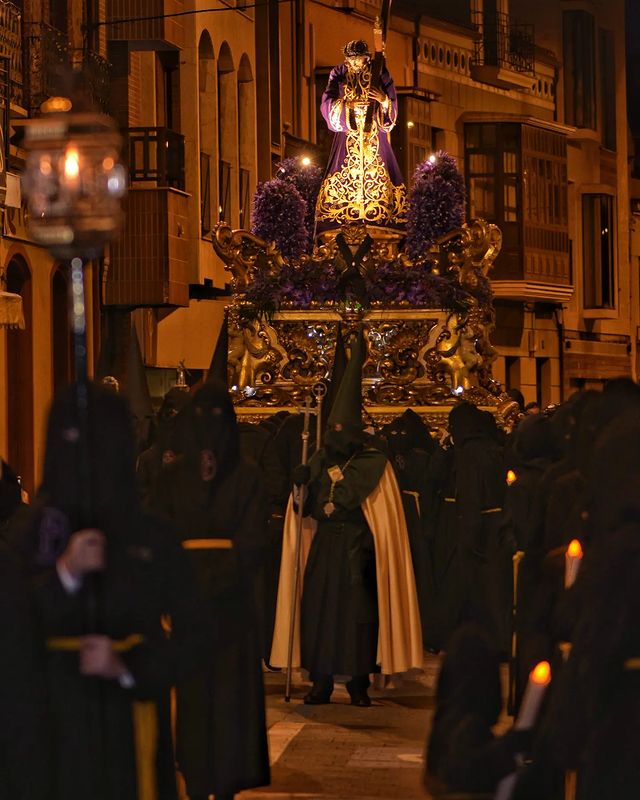
Semana Santa, or Holy Week, is one of the most significant holidays leading up to Easter. Throughout this week, processions featuring biblical characters dedicated to the Passion of Christ are held. This holiday is celebrated throughout Spain.
Feria de Abril
Feria de Abril, or the April Fair, is one of Seville’s major holidays. The atmosphere is charged with music, food, and dance, fostering an indescribable desire for fun. What began as a cattle fair in 1847 gradually morphed into a festive occasion, becoming a grand event for Seville’s residents. Throughout the week, over a thousand kiosks installed at the exhibition complex become second homes for the locals, places where they can gather and enjoy each other’s company until the early hours of the morning.
San Juan
The San Juan Festival is another big party that happens every year on June 23rd in Spain. This party happens mostly on the beach late at night, and everyone has a good time with food, music, and lots of bonfires (called the bonfires of St John). Why bonfires? Well, many people think they can keep away bad spirits. 🙂
Anyways, no matter what they believe in, there is one common thing that people do on the night of San Juan: jumping over the fires. This is supposed to make the sun stronger, get rid of problems, and bring good luck. Some people jump three times, others jump up to nine times.
In some cities, like Malaga, people write down their wishes or things they want to forget on pieces of paper and then throw them into the fire when the clock strikes midnight.
Three Kings Days
El Día de Reyes Magos is widely celebrated throughout Spain and is a favorite holiday among children. The traditional parade of the Magi takes place on January 5. This colorful event holds interest for tourists visiting the country. This holiday tradition has been observed since 1866.
El toro embolado
“El toro embolado” is a traditional celebration in eastern Spain in which two fireballs are affixed to a bull’s horns. This folk tradition is prevalent in the provinces of Castellon and Valencia, Teruel, as well as the provinces of Tarragona in Catalonia. This custom is similar to bullfighting, but the animal is not killed. The origin of this custom can be traced back to pagan traditions and the Roman era.
Here is a list of the main holidays in Spain:
- New Year – January 1st
- Epiphany (Day of the Three Kings) – January 6th
- Good Friday – April 7th
- Easter* – April 9th
- Labor Day – May 1st
- Assumption of the Virgin – August 15th
- Spain Day – October 12th
- All Saints’ Day – November 1st
- Constitution Day – December 6th
- Immaculate Conception Day – December 8th
- Christmas – December 25th
Gift Giving in Spain
In Spain, it’s common to give beautifully packaged gifts when visiting someone. These gifts can include tasty items like sweets or chocolate, a homemade dish, or a bottle of wine or beer.
Interestingly, flowers are typically given only on specific occasions such as hospital discharges or funerals.
Weddings in Spain
Most Spanish weddings take place from May through August. The wedding date is typically set well in advance, often at least a year prior to the planned Wedding Day. The parents of both the bride and groom prepare Bible readings in advance for the ceremony.
One of the touching traditions during the wedding is the exchange of 13 gold coins, known as “arras”. These coins are blessed by the priest, and then the groom transfers the coins from his hand to the bride’s hand as a symbol of his promise of love and fidelity. The bride then repeats the same gesture. It’s not customary in Spain to bring flowers to a wedding.
Traditional Clothing in Spain
Spanish traditional clothing is as diverse as the country’s cultural traditions, with varying styles across different regions. In central and southern Spain, flamenco, rural, bullfighting, and Arab influences are prominent, with the most iconic being the “trajes de faralaes,” multi-layered flamenco dresses abundant with frills. Men’s clothing in these regions typically consists of a “traje de corto,” or “short suit.”
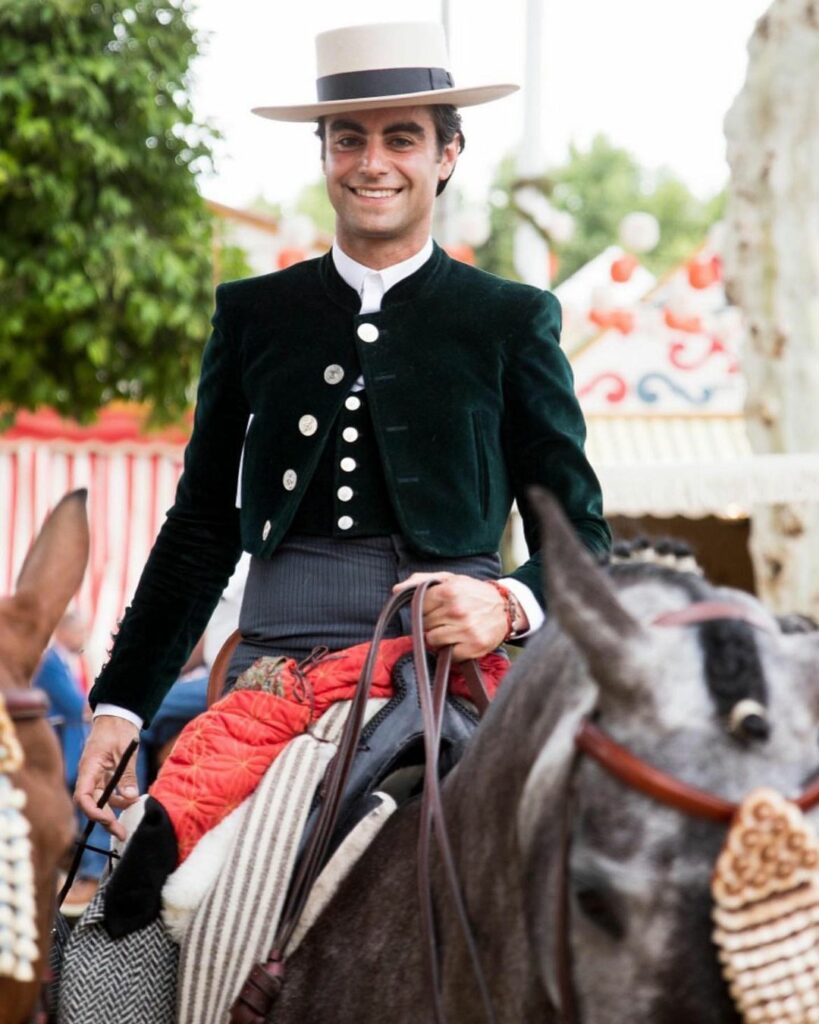

Notable accessories include the “mantilla,” a lace cape, and “peineta,” a supportive comb for women. For matadors, their richly embroidered costumes signify their status in the culturally significant bullfighting tradition. In contrast, northern Spain’s attire reflects Celtic influences, with more subdued colors and less elaborate embroidery, predominantly featuring floral motifs.
Food Traditions in Spain
Food culture is a cornerstone of Spanish life. In few words I would describe it as a fusion of Arabic, Roman, Jewish, and Mediterranean cuisines.
A contemporary Spanish chef relies on rather simple ingredients such as potatoes, tomatoes, peppers, beans, garlic, onions, lettuce, and olive oil. Another characteristic of Spanish dining is the customary serving of bread with most dishes and the tradition of drinking wine during meals.
Paella is the most internationally recognized dish. With a combination of rice, chicken, rabbit, green beans, and other ingredients, it’s impossible to resist. This dish originates from the Valencian Autonomous Community and is popular throughout Spain.
Potato tortilla, a gem of the Mediterranean diet, is made from potatoes, eggs, and olive oil. It can be ordered with or without onions, although many Spanish people will disagree about the no-onions version.
Jamon (Iberian ham) is another delicacy that has been recognized around the world, boasting four geographical quality certificates. Once you’ve tasted it, you’ll undoubtedly want more.
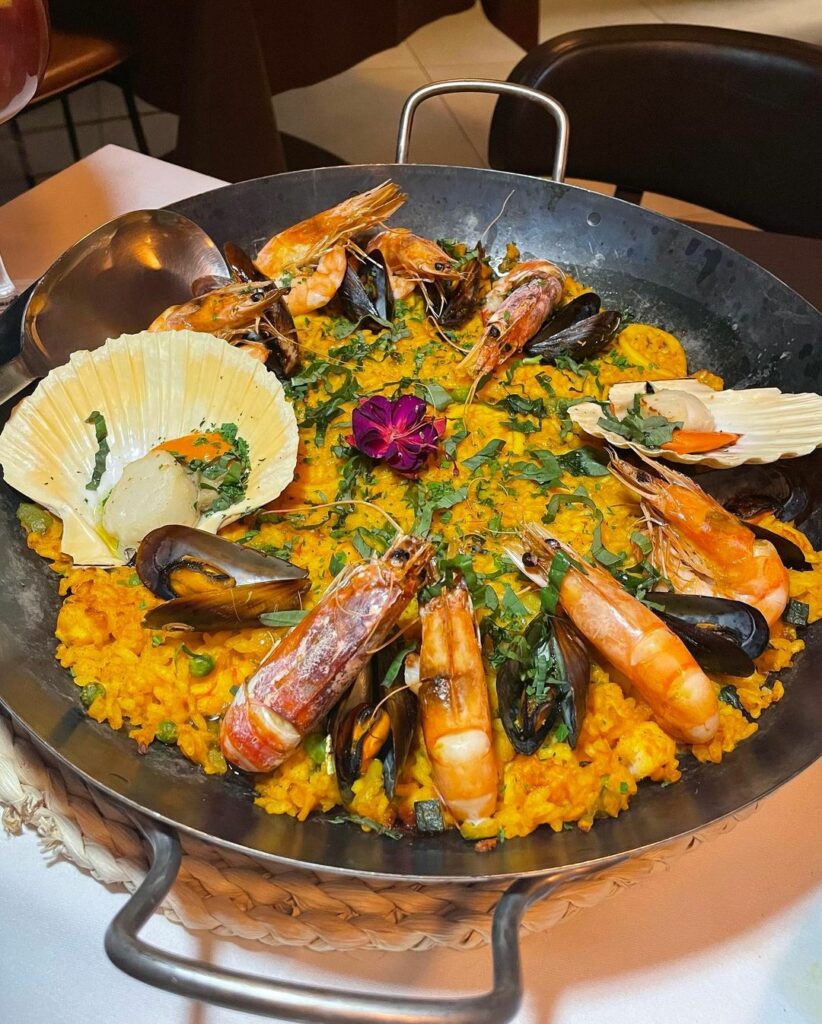
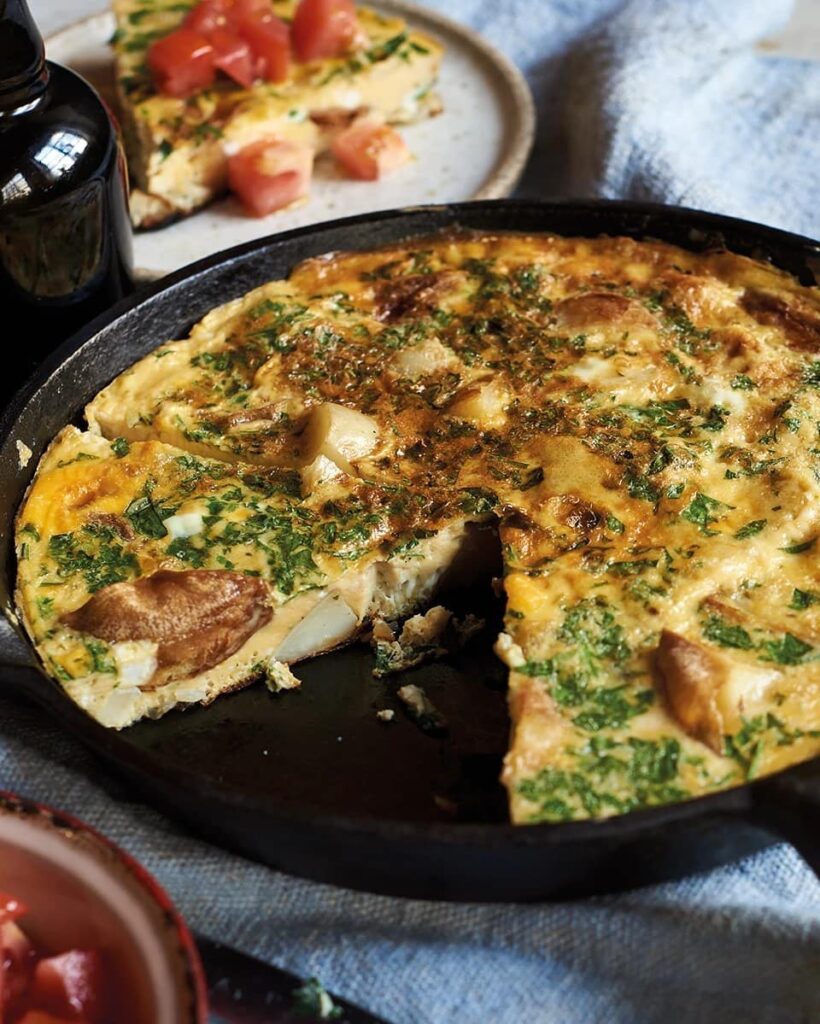
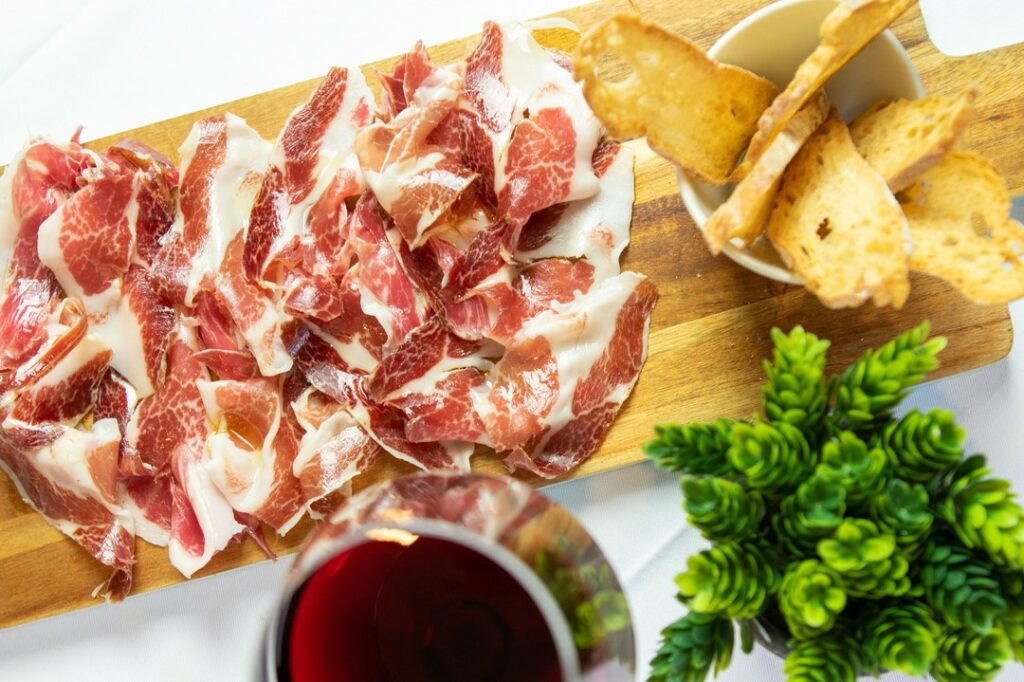
Did you know? The thinner the piece of jamon is cut, the tastier it is.
Now, let’s focus on some of the most notable dishes of regional cuisine in Spain.
In the southern part of Spain during the summer months, there’s no better way to beat the heat than with a well-chilled gazpacho tomato soup. Besides tomatoes, it includes cucumbers, onions, olive oil, and garlic, typically served with toast and red pepper.
The pride of Basque cuisine is the dry white wine txakoli, or chacoli, often used in preparing traditional Basque dishes. One such dish is horse mackerel with chacoli. The fish is usually cooked in a saucepan, with added tomatoes, onions, carrots, leeks, garlic, oil, and a glass of chacoli. The perfect Basque horse mackerel with chacoli can be tasted in the restaurants of Bilbao and San Sebastian.
When in Teruel, trying Teruel’s migas is a must: bread is cut, soaked in salted water for a day, and then fried with butter and garlic, continuously stirred. The resulting dish is a unique, delicious, and satisfying bread crumb concoction, reminiscent of couscous. For more taste complexity, pieces of pork, sausage, or even grapes can be added to the migas.
The aromatic appetizer, escalivada, is a Catalan dish of eggplant with red pepper. For preparation, vegetables are roasted over an open fire or grilled until the skin turns black. They are then covered with a plate and cooled, after which the eggplant and pepper are peeled and cut into strips. Most commonly, toasted bread soaked in tomato juice and oil, anchovies and onions, and sometimes tuna are served with the vegetables.
The unique Navarre cuttlefish, cooked in its own ink, might initially bewilder an unprepared tourist. However, once tasted, any apprehensions will vanish. When preparing cuttlefish, a common technique involves using its own ink for flavor and artificial ones for color intensity. Onions, garlic, parsley, cayenne pepper, and an essential glass of wine add a touch of spice to the dish.
Dining Etiquette
Most social events in Spain, as well as family celebrations, typically involve dining. One of the most crucial etiquette rules encompasses “la sobremesa” — the practice of remaining at the table and conversing for several hours after a meal. Interestingly, during this time, it’s considered improper to hide your hands under the table. Instead, you should keep your wrists on the table, with your elbows above it.
Eating Out
Usually, the host invites others and pays for the meal. In return, you may reciprocate by inviting them out, at which time you would be expected to foot the bill. If you’re dining at a restaurant with friends, it’s normal to divide the bill equally among everyone. In Spain, it’s also not typical to leave a tip.
Read also: Do’s & Don'ts of Tipping in Spain Important! Meal breaks in this country are virtually sacred, even on workdays.
Family Structure and Values in Spain
In Spain, family isn’t just important – it’s everything, and family bonds are super tight. Spanish folks highly respect their elders, and it’s pretty common to see three generations living together under the same roof.
Got a birthday, saint’s day, or holiday coming up? Expect to celebrate it with a big ol’ family gathering of twenty to thirty relatives. And when it comes to personal life, Spanish people generally keep things under wraps. If there’s an issue, they’ll handle it within the family. Even young folks who’ve started working usually still lean on their parents for support.
For a long time, the Catholic Church had some pretty strict rules about how women should behave – rules that didn’t apply to men. Women were often kept out of the workplace and were expected to fill the role of wife and mother.
But things have changed a lot since the end of the Franco dictatorship. Nowadays, girls have way more job opportunities once they finish school, and young women are focusing more on their careers. They’re not rushing to get married, and getting divorced isn’t the big deal it used to be. In short, family relationships in Spain are continually evolving to keep up with the times.
Spanish Double Last Names
In Spain, everybody has two last names – one from their dad, and one from their mom.
When a woman gets married, she doesn’t change her last name officially, so she’ll still sign documents with her maiden name. A kid gets their dad’s first surname followed by the mom’s first surname. For example, the boy’s name is Daniel, and his last name is Cortes Montero.
Also, there’s no such thing as a patronymic, and sometimes you’ll even see double first names, like MaryLuz.
Typical Daily Routine in Spain
After waking up, Spaniards have a light breakfast, which usually consists of strong coffee and a small snack. Most have almuerzo, or mid-morning light meal, between 11 AM and 2 PM.
Lunch is usually served between noon and 3 PM
Dinner time is usually around 10 PM. Bedtime is usually after midnight.
On weekends, you can expect a lot of busy streets with people going out and hanging out with their friends and family. Expect bars and clubs to be crowded around 11 PM. On Sundays, everything is slow and quiet, with almost all shops and grocery stores closed.
Also, Spaniards do not like to stay at home, and they quickly become cramped and bored in confined spaces. After a family dinner, if it takes place in the house, they go out into the streets to chat with neighbors and relatives.
This tradition is called “paseo” and is a whole evening promenade. They can just walk around the city, drop into a bar, and listen to the latest news.
The Siesta
The scorching midday heat adjusts the daily routine of the inhabitants of the Iberian Peninsula, who prefer to be active only in the morning and evening. As a consequence, from around 2 PM to 5 PM, it is the siesta time, a midday break, when the streets of many smaller Spanish towns become deserted, with all institutions and shops closed.
In larger cities, the idea of a siesta is gradually fading, and the lunch break lasts 1-2 hours. There is simply no siesta in chain stores, and they work according to the usual schedule.
Is the Siesta a Myth in Spain?
Nowadays, the Spanish siesta, which is often associated with sleeping, is more myth than reality. Research shows that only approx. 16% of Spanish people take a nap every day, while 58% never nap at all. This counters the popular belief of Spaniards indulging in long afternoon siestas.
Interestingly, a 2009 US study showed that 34% of Americans nap on any given day.
Religions in Spain
Spain and religion are pretty tight concepts, nearly inseparable, really. Way back in the eighth century, the Arabs came rolling in, taking over the Iberian Peninsula. For centuries, most of Spain was under Muslim rule. Then, the Reconquista happened and voila, the Catholic Church dominated the peninsula.
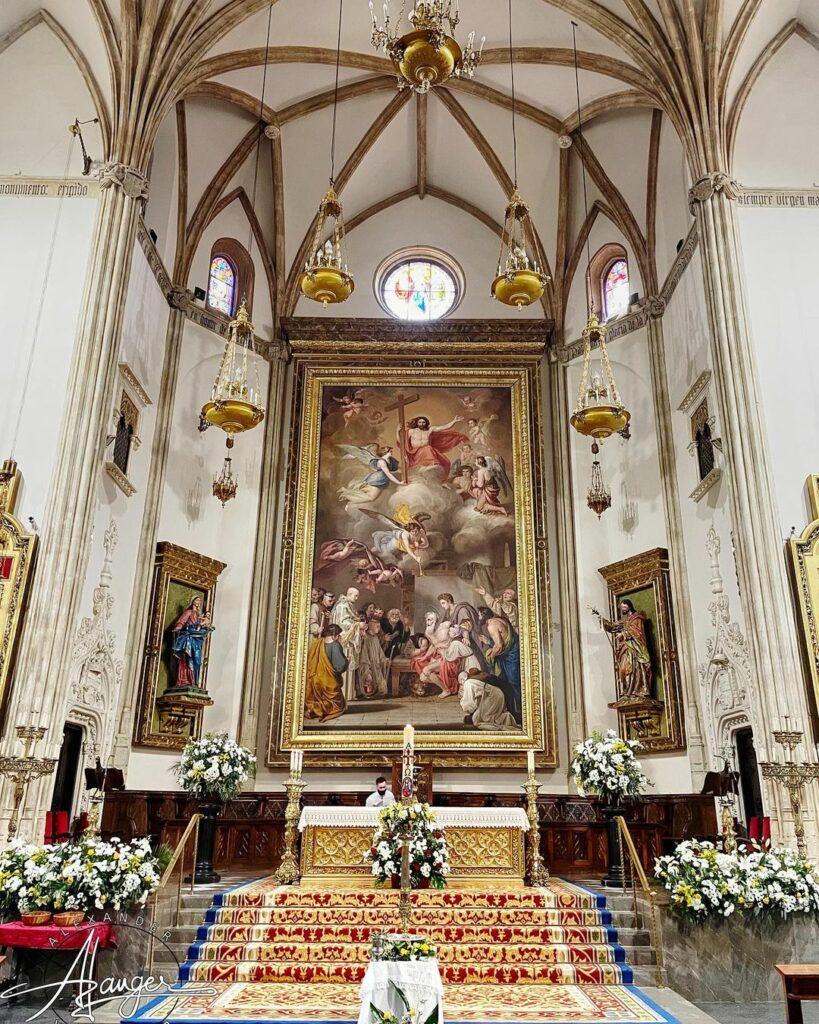
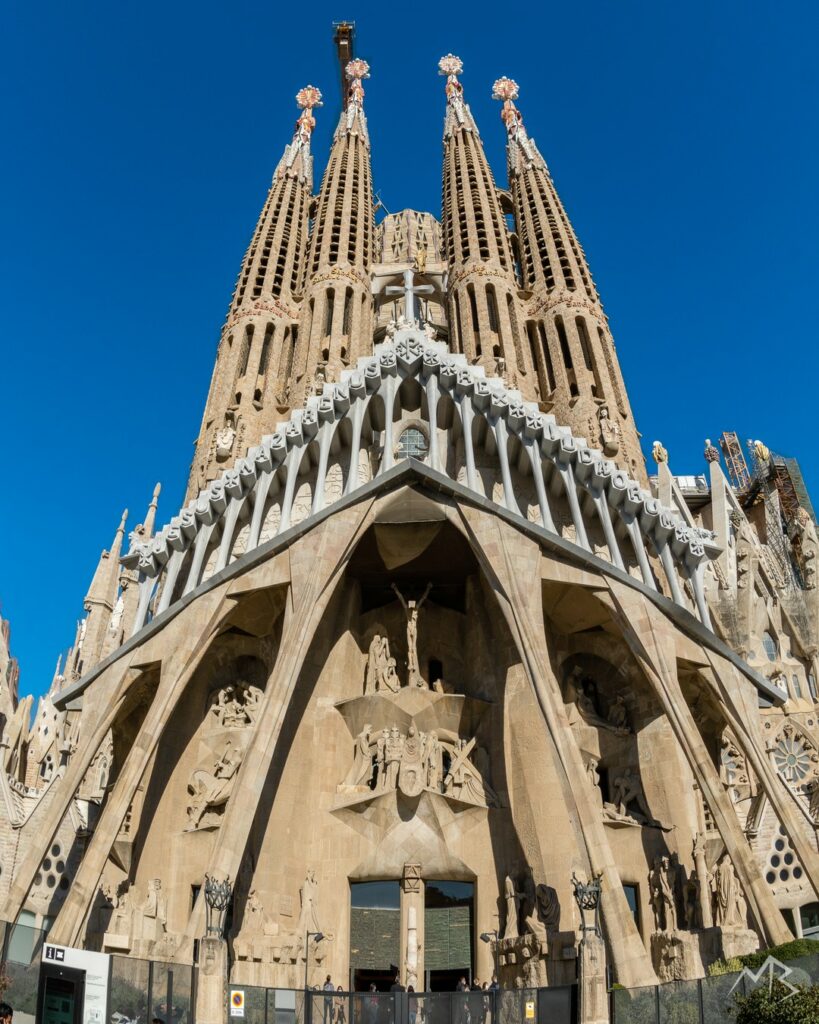
Fast forward to the 1930s, and it was a rough ride for Spanish Catholicism. The Civil War had people burning down temples, and there were even whispers about poisoned sweets for priests’ kids. Talk about a horror movie plot! In the aftermath, the Church threw its support behind Franco and his crew.
Once in power, Franco gave the Catholic Church a big thumbs up, declaring Catholicism as the only legit religion. That meant the Church could do a lot – print books, own property, and even get their fingers into legislative pies related to civilian life. Laws were passed that recognized only church marriages, banned divorce, abortion, and the use of contraceptives.
Naturally, with such a long time under Catholic influence, Spain started to look pretty Catholic – today, 80% of the population identify as Catholics. But the Church doesn’t have much pull in the state’s affairs these days. After the downfall of Franco’s regime, a new constitution was introduced, giving Spain a fresh coat of secular paint. Freedom of religion was proclaimed, divorce got the green light, and religious education in schools became optional. Finally, every Spaniard could pick any religion they wanted.
About 2% of Spaniards identify with other religions, with most of that number being Muslims. And roughly 18% don’t affiliate with any religious denomination, calling themselves atheists.
Spanish Traditions
Spanish people have a national habit of putting things off until “mañana” (tomorrow). And it’s not because they’re lazy, but because they value personal freedom. After all, it’s the individual that comes first in Spain. Oh, and don’t let “mañana” fool you – it doesn’t necessarily mean tomorrow, but more like “later.”
Spaniards are a sociable and friendly bunch, always ready for a chat and never missing an opportunity to start a dialogue. You could say Spain is a country of happy folks – it’s a rare sight to see a tired or grumpy face here. You’ll even find waiters in restaurants getting into the groove, often humming or even dancing as they take your order. Don’t be surprised if someone on public transport breaks into song or busts a move, either!
When it comes to treating others with respect, Spain nails it. That includes tourists, too. Locals are never in a rush and are always ready to lend a hand, answer questions, show you the way, or even hang out with you.
If flattery gets you everywhere, then Spaniards are world travelers. In the market or bazaar, girls might be addressed as “princess” or “queen,” or even “guapa” (beauty). For the gents, they might be called “Caballero” (gentleman) or “Señor” (sir). But remember, as friendly as they are, Spaniards value and respect personal space.
The Spanish way of life is calm and relaxed. This is evident in every aspect of life, like when a salesperson takes the time to chat with a customer about unrelated topics, or chats with a colleague while the queue grows. But don’t worry, you won’t get short-changed on service.
Now, I can’t talk about Spanish traditions without mentioning football. It’s practically a religion here that you just can’t ignore. Football matches are a major social event, whether you’re watching at home with friends, at a bar, or in the stadium. You’ll get swept up in the excitement when you see folks decked out in their team colors, clapping, singing, and shouting their support.
Cities like Barcelona, Madrid, and Valencia have their own superstar teams, and the rivalry can get fierce. Each team has its own kit and fan gear, so make sure to wear the right colors and cheer for the right team if you head to a match. And hey, brush up on your football vocab if you don’t want to feel like an outsider among the fans.
Taboos and Superstitions in Spain
When it comes to Spanish culture and traditions, there are certain no-go zones that are best to steer clear of. One day, to switch things up from the usual chit-chat about the weather, I tried to engage a local from Valencia in a conversation about Catalonia and Spain. Let’s just say I was bombarded with negative vibes towards not only Catalans but also myself, as a foreigner who dared to compare Catalonia and Spain.
So, take it from me, bringing up Catalonia-Spain relations is a bit of a hot potato – people can get pretty heated about it.
Read also: What is Considered Rude in Spain (Do’s and Don’ts)In the past, women in Spain were seen primarily as mothers and homemakers, relying on men for most things. But fast-forward a few decades to when women got equal rights, and you’ll see the pendulum has swung in their favor, igniting a powerful feminist movement. Nowadays, men are even wary of showing attention to unfamiliar women for fear of being accused of machismo. There have been several court cases splashed across the media concerning this issue.
In the superstition department, watch out for Tuesday the 13th – it’s considered an unlucky day in Spain. So, if you’re planning anything, maybe choose a different date. And while we’re on the topic of 13, avoid giving a bouquet of 13 flowers to anyone – it’s an unlucky number.
When it comes to clothing, Spaniards have long adapted to the heat and don’t usually break out the shorts and T-shirts before the official start of summer. Instead, they stick to trousers and long-sleeved clothing. And summer here doesn’t kick off until June 22 and wraps up on September 22.
Values and Beliefs
- Spaniards are typically outgoing and friendly. Modesty and individuality are prized traits, even in the face of professional or business success.
- Business communication involves the skillful and polite airing of issues. Confrontation should be avoided.
- Younger Spaniards often strive to learn English. However, for daily living, knowledge of Spanish is crucial.
- While university education is valued as a springboard to good societal positions, all kinds of work are respected. Many are content with jobs that afford an average standard of living.
- Family traditions are cherished, the older generation is respected, and children are adored. Schools encourage children to voice their opinions and foster a respect for others’ views and feelings.
- Spain’s healthcare system is globally recognized for its high quality and access to affordable insurance with unlimited coverage.
- Spain enforces strict environmental conservation laws, with a significant proportion of its electricity sourced from renewables.
- Bureaucratic procedures and delays are common in Spain, and adherence to document requirements is strict.
Contemporary Spanish Culture and Influence
Spanish culture is deeply rooted in the ancient traditions of Rome. For centuries, Spain was a vital player in the Greco-Roman world. Even the name “Spain” comes from the moniker “Hispania,” which the Romans used to call the country. The country’s cultural tapestry also bears imprints from other ancient civilizations, including Greeks, Tartessians, Celts, Iberians, Celtiberians, Phoenicians, and Carthaginians. A whopping 75% of modern Spanish springs from Latin, with ancient Greek and Arabic also contributing significantly to the language’s vocabulary.

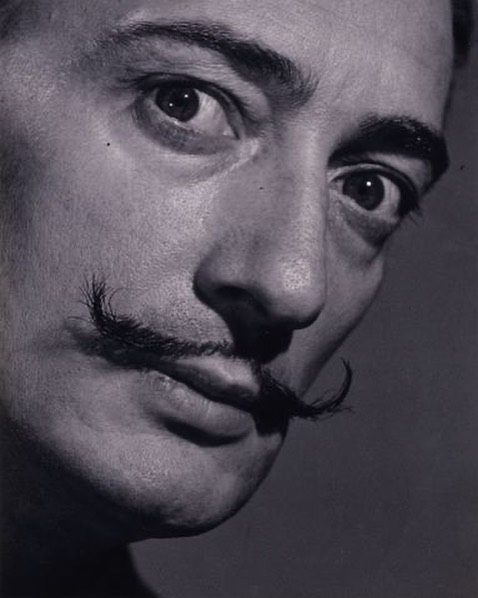

Spain is a treasure trove of culture. Let’s talk literature – “Don Quixote” by Miguel de Cervantes is considered the crowning jewel of Spanish literature, despite being over 400 years old! Spain has also given the world incredible talents like playwright Lope De Vega and the distinctive architect, Gaudi. The country’s Golden Age churned out globally celebrated artists such as El Greco, Diego Velasquez, and Francisco Goya. Fast forward to the 20th century, Pablo Picasso has been making waves in the world of abstract art, with other big names including Salvador Dali and Joan Miro.
Music’s up next, and Spain does not disappoint. The country has birthed super-talented songwriters and performers, like Placido Domingo, the father-son duo of Enrique and Julio Iglesias, Paco de Lucia, Alejandro Sanz, and Rosalía (my favorite singer, by the way!).


Then there’s the world of Spanish cinema, boasting a brilliant mix of creative and technical prowess. Legendary directors like Luis Bunuel and Pedro Almodovar (still going strong!) have paved the way for the likes of Penelope Cruz, Fernando Rey, Antonio Banderas, Javier Bardem, and Fernando Fernan Gomez.
It’s also worth noting that Spanish movies currently make up 10 to 20% of the box office in Spain, with the rest taken by foreign films – a trend seen in many European and American countries. But, the tide is turning, with an uptick in Spanish productions. Recently, we’ve seen English-language Spanish films make a splash, including “The Machinist” (with Christian Bale), “Others” (starring Nicole Kidman), “Basic Instinct 2” (featuring Sharon Stone), and “Ghosts of Goya” (starring Javier Bardem and Natalie Portman).


So, there you have it – a whirlwind tour of Spanish culture. It’s not just about historical richness and a plethora of national and regional festivities. It’s also about the genuine warmth and hospitality that’s distinctly Spanish. 😊
Spanish Culture and Traditions FAQ
Christopher Columbus was Italian. He was born in 1451 in the Republic of Genoa, which is part of modern-day Italy. However, it was under the sponsorship of the Spanish monarchs Ferdinand II of Aragon and Isabella I of Castile that Columbus embarked on his famous voyage in 1492, leading to the widespread recognition of the Americas by Europeans.
In Spain, food is more than just fuel for the body – it’s a reason to gather and shoot the breeze with friends and family. Tapas bars are practically on every corner, serving as a communal hub where locals meet and mingle several times a week. The tradition of breaking bread together is a cornerstone of everyday Spanish life.
“Tapas” and “Pintxos” are both types of small dishes or snacks from different regions in Spain. Tapas can be any small serving of food, from olives to seafood, and are typically enjoyed with a drink across Spain. “Pintxos,” from the Basque Country, are usually skewered foods served on a slice of bread. They range from simple to elaborate presentations and are often displayed on a bar counter for customers to select. Both form a significant part of Spanish culinary and social culture.
In Spain, the superstition around bad luck is not associated with Friday the 13th. Instead, they consider Tuesday the 13th (“martes trece”) to be a day of bad luck. This belief is tied to a range of historical, religious, and cultural reasons, including the association of Tuesday with Mars, the Roman god of war, and the fall of the city of Constantinople on a Tuesday in 1453.
Yes. It is the second most commonly spoken language by total number of speakers, coming in only after Mandarin Chinese. It is the official language of 21 countries, and is also widely spoken in many other countries, including the US. Globally, there are more than 474 million people who speak Spanish as their first language, and when including second-language speakers, the total number exceeds 540 million.
